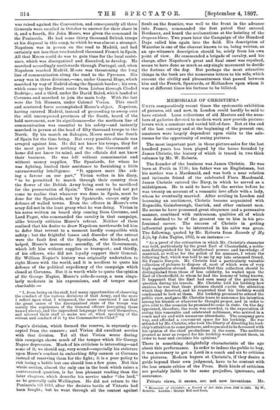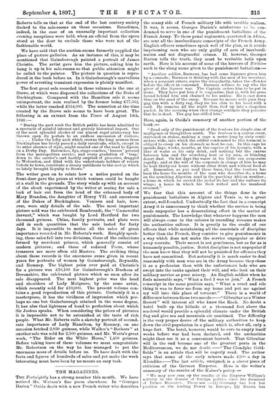MEMORIALS OF CHRISTIE'S.* UNTIL comparatively recent times the systematic exhibition
of pictures, old and new, in London could hardly be said to have existed. Loan collections of old Masters and the num- bers of galleries devoted to modern work now provide picture- lovers with a constant and varied bill-of-fare. But at the end of the last century and at the beginning of the present one, amateurs were largely dependent upon visits to the sale- rooms for the opportunity of seeing pictures.
The most important part in these picture-sales for the last hundred years has been played by the house founded by James Christie, the history of which is traced in two thick volumes by Mr. W. Roberts.
The founder of the business was James Christie. He was born at Perth in 1730; his father was an Englishman, but his mother was a Macdonald, and was both a near relation and intimate friend of the celebrated Flora Macdonald. James Christie entered the Navy, in which he served as a midshipman. He is said to have left the service before he was twenty on account of a romantic love affair with a lady, whom he eventually married. After settling in London and becoming an auctioneer, Christie became acquainted with
Reynolds, Gainsborough, Garrick, and other eminent men. He seems to have possessed great eloquence and a persuasive manner, combined with enthusiasm, qualities all of which were destined to be of the greatest use to him in his pro- fessional career. The success of Christie in getting influential people to be interested in his sales was great. The following, quoted by Mr. Roberts from _Records of My Life, by John Taylor, 1832, is an instance :— " As a proof of the estimation in which Mr. Christie's character was held, particularly by the great Earl of Chesterfield, a noble- man distinguished for his intellectual powers and knowledge of mankind, as well as for the polish of his manners, I relate the following fact, which was told to me by my late esteemed friend, Sir Francis Burgois. Mr. Christie had a particularly valuable collection of pictures to dispose of, most of which were of very high reputation abroad. Anxious that this collection should be distinguished from those of less celebrity, he waited upon the Earl of Chesterfield, to whom he had the honour of being known. It happened that the Earl had seen many of the pictures in question during his travels. Mr. Christie told his lordship how anxious he was that these pictures should excite the attention which they deserved, and he requested that his lordship would condescend to look at them. His lordship promised to attend the public view, and gave Mr. Christie leave to announce his intention among his friends or wherever he thought proper, and in order to give éclat to the occasion he promised to come in state. On the day appointed, therefore, the room was crowded, in the expectation of seeing this venerable and celebrated nobleman, who arrived in a coach and six and with numerous attendants. The company gave way, and afforded a convenient space for his lordship. He was attended by Mr. Christie, who took the liberty of directing his lord- ship's attention to some pictures, and requested to be favoured with his opinion of the chief productions in the room. The auditors pressed as near as respect for his lordship would permit them, in order to hear and circulate his opinions."
There is something delightfully characteristic of the age about this performance. In order to induce the public to buy, it was necessary to get a Lord in a coach and six to criticise the pictures. Modern buyers at Christie's, if they desire a
guide beyond their own judgment, have to be content with
the less ornate critics of the Press. Both kinds of criticism are probably liable to the same prejudice, ignorance, and
assurance.
Private views, it seems, are not new inventions. Mr.
* Memorials of Christie's : a Record of Art Sales from 1766 to 1896. Br W. Roberts. London : George Bell and Sons,
Roberts tells us that at the end of the last century society flocked to the sale-rooms on these occasions. Sometimes, indeed, in the case of an unusually important collection evening receptions were held, when an official from the opera stood at the door to exclude those who were not of the fashionable world.
We have said that the auction-rooms formerly supplied the place of picture galleries. As an instance of this, it may be mentioned that Gainsborough painted a portrait of James Christie. The artist gave him the picture, asking him to hang it up in his sale-rooms so that public attention might be called to the painter. The picture in question is repro- -duced in the book before us. In it Gainsborough's marvellous power of arresting transient expression is plainly manifest.
The first great sale recorded in these volumes is the one at Stowe, at which were dispersed the collections of the Duke of Buckingham. Compared with the Hamilton sale it seems unimportant, the sum realised by the former being 277,562, while the latter reached 2554,005. The sensation at the time created by the Stowe sale seems to have been great. The following is an extract from the Times of August 14th, 1848 :—
" During the past week the British public has been admitted to a spectacle of painful interest and gravely historical import. One of the most splendid abodes of our almost regal aristocracy has thrown open its portals to an endless succession of visitors. . . . . . Under the lofty arch which crowns the long avenue from Buckingham has lately passed a daily cavalcade, which, except in its utter absence of style, might remind one of the road to Epsom on a Derby Day. Barouches, flys, stage-coaches, 'busses' pressed from the metropolitan service, and every gradation of 'trap,' down to the carrier's cart hastily emptied of groceries, dragged to Wolverton, and filled with the unfortunate holders of return tickets to town, constitute a dreary antithesis to the cortege which so lately brought Royalty to Stowe."
The writer goes on to relate how a notice posted on the front-door gave the prices at which venison could be bought at a stall in the grounds. The story winds up with an account of the shock experienced by the writer at seeing for sale a lock of hair cut from the head of the exhumed body of Mary Brandon, the daughter of Henry VII. and ancestress of the Dukes of Buckingham. Venison and hair, how-
ever, were only details of the sale. The most important picture sold was the celebrated Rembrandt, the "Unmerciful Servant," which was bought by Lord Hertford for two thousand guineas. China, family portraits, and plate were sold in such quantities that the sale lasted for forty days. It is impossible to notice all the sales of great importance recorded in Mr. Roberts's work. Roughly speak- ing, these sales fall into two divisions, those of the collections formed by merchant princes, which generally consist of
modern pictures ; and those of reduced Peers, whose treasures are more often old Masters. The striking thing about these records is the enormous sums given in recent years for portraits of women by Gainsborough, Reynolds, and Romney. The highest price ever paid at Christie's for a picture was 210,100 for Gainsborough's Duchess of Devonshire, the celebrated picture which so soon after its sale disappeared. The next highest price was the head and shoulders of Lady Mulgrave, by the same artist, which recently sold for 210,000. The present volume con- tains a good reproduction of this picture. Certainly it is a masterpiece, it has the vividness of impression which per- haps no one but Gainsborough attained in the same degree. It has also that lightness of hand to perfection about which Sir Joshua speaks. When considering the prices of pictures it is impossible not to be astonished at the taste of rich people. What Mr. Roberts calls a sketchy portrait of second- rate importance of Lady Hamilton, by Romney, on one occasion fetched 2,030 guineas, while Walker's " Bathers " at another sale was sold for 2,500 guineas, and Mr. Watts's great work, "The Rider on the White Horse," 1,450 guineas. Before taking leave of these volumes we must congratulate
Mr. Robertson on the way he has 'managed to put the enormous mass of details before us. To have dealt with the
facts and figures of hundreds of sales and yet make the work interesting must have been by no means an easy task.



































 Previous page
Previous page